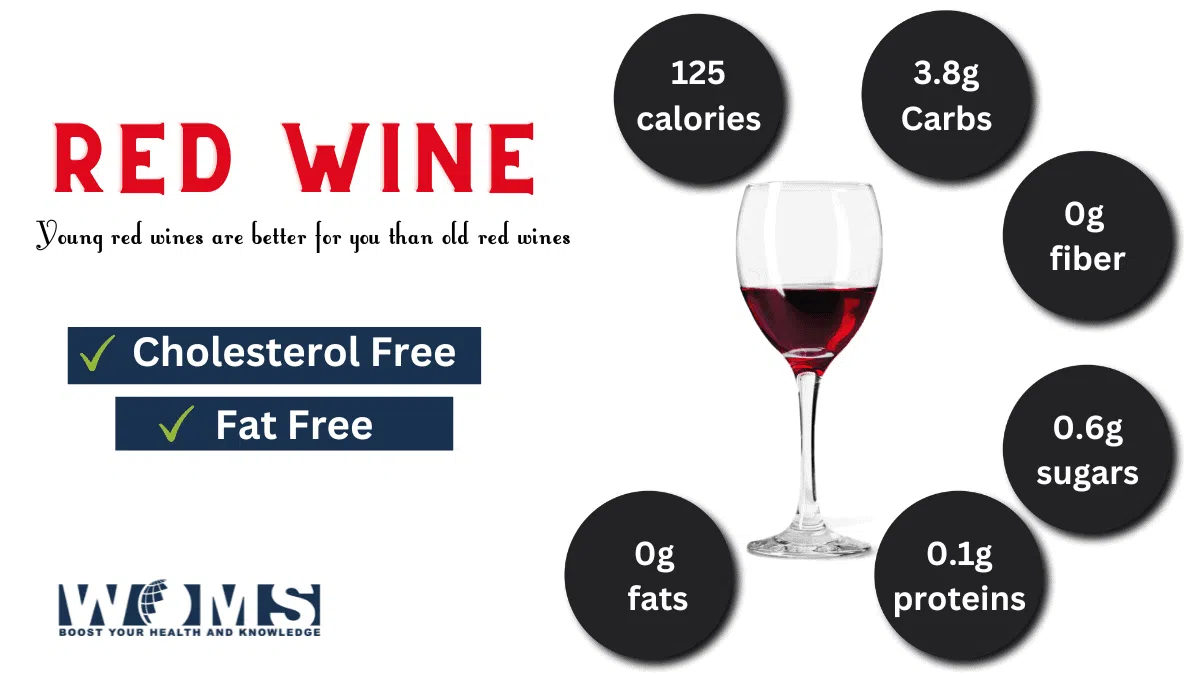Calories in red wine: Health benefits and adverse effects

If you are stressed out about the calories in red wine, here is an elaborated explanation regarding the calorie count of red wine. Most people want to figure out the calories to adjust red wine into a regular diet without gaining weight. The calorie count is usually not written on the bottle. How to calculate calories in red wine is a question for some people.
Calculating calories for a glass or bottle of red wine is not an easy task. It depends on multiple factors. The type of red wine you are drinking, the amount of alcohol, and many other factors provide details about the calories. Continue reading the article to know how to calculate and from which ingredients these calories come.
What are the ingredients that provide energy in the form of calories?
Before getting into details, let us get to know where these calories are coming from. Red wine is processed after a long procedure of fermentation. The yeast breaks down the sugars present in grape juice into alcohol and carbon dioxide. Some sugar is converted into alcohol, whereas the rest of the sugar remains as residual sugar. This provides information about two basic sources of calories in red wine in the form of sugar and alcohol.
Sugar or carbs
Sugars are in the form of carbohydrates. Leftover residual sugars determine the amount of carbohydrates in the red wine. These carbohydrates provide 4 calories per gram to wine. A light red wine may offer 3 grams of calories in the form of carbohydrates per 150ml. In comparison to this, a dessert type of red wine delivers 20 grams of carbohydrates. Dry wine also delivers the same amount of residual sugars.
Alcohol
Alcohol provides almost double the amount of calories as compared to carbohydrates. It is about 7 calories per gram. Alcohol metabolism is quite different from carbohydrates. Therefore, alcohol does not contribute to the total carbohydrates in red wine.
How to calculate the calories in red wine?
It is quite tough to pour the accurate calories of red wine into the glass. Most bottles list the ABV values for you to easily calculate the calories. But, you can also make an educated guess. There are 158 calories in every ounce of pure alcohol. Here is a formula for you to calculate the calories in your desired red wine.
Red wine calories = ounces × ABV × 1.6
Let’s suppose the value of ABV is 13% in a 7 ounces drink of red wine.
Red wine calories = 7 × 13 × 1.6
Red wine calories = 146
So, in this way, you can easily calculate the calories in red wine.
Can red wine be healthy?
Red wine if used properly in smaller doses can provide multiple health benefits. The National Institute of Health recommends only light or moderate level drinking. Moderate drinking explains about one drink per day for women and one to two drinks per day for men. Experts do not recommend using red wine to gain health benefits. It is only applicable to people who are addicted to drinking. After knowing the calories ij red wine, here are some health benefits associated with low to moderate level red wine drinking.
Improves heart health
There is a flavonoid named resveratrol present in red wine. Studies suggest that it helps to improve heart health. Resveratrol neutralizes the free oxygen radicals to prevent any damaging effects of them. It helps to prevent blood clots and decreases the overall chances of any chronic illness.
Improves mental health
Studies suggest good impacts of red wine on the mental health of patients specifically dealing with depression. It determines that a low to moderate intake of the consumption of red wine may lower the risk of depression. Whereas, there is also a warning of the opposite effects for heavy drinkers. They have an increased chance of depression.
Increased longevity
Considering an overall Mediterranean diet, red wine has positive effects on increased longevity. Consuming moderate amounts of red wine prevents multiple diseases and promotes longer life.
Improves cognitive functions
A study published in 2020 suggests that a regular diet containing cheese, lamb, or red wine helps to improve cognitive functioning. It helps to relieve the increased risks of Alzheimer’s disease. Dietary changes reduced the significant changes of cognitive decline.
Allergic response to the red wine
After knowing the calories in red wine, let’s get into some related topics. Alcohol including red wine can interfere with the metabolism of different medications. It can specifically interact with the medicines that depress the central nervous system and cause drowsiness. Read your medication labels properly and consult your physicians regarding the consumption of red wine with medications. In this regard there are queries like Can we take flagyl and alcohol together?
In addition, it can aggravate multiple respiratory problems and may induce allergic reactions due to alcohol interference. The common symptoms include hives, flushing, and swelling of the lips. If you suffer from any such symptoms, seek immediate medical care from your healthcare physicians.
What are the adverse effects of using red wine?
Low to moderate drinking can provide you with some health benefits without causing any metabolic problems. Excessive drinking of red wine has negative effects and some drastic consequences. These adverse effects include liver problems, cardiovascular diseases, malignant growths, injuries from accidents, or death. Adults should limit their intake to two drinks per day. Pregnant ladies must avoid alcohol or wine in any form. You should check this detailed article to know about this more Can pregnant women drink wine?
Excessive drinking can cause alcohol use disorder. It raises the chart of multiple metabolic disorders affecting the quality of life in a variety of ways. Besides knowing the calories in red wine, it is also essential to know the adverse effects of drinking it.
How to consume red wine in a healthy way?
Now that you know about the calories in red wine, let’s know how to consume it. Red wine can be healthy if you consume it in a proper way. Moreover, it will also help you to stay slim even after drinking red wine. Monitor your serving size. A proper serving of red wine is about 5 ounces, not a complete glass of 20 ounces.
Our bodies have a specific metabolic rate to consume alcohol every day. There is a limit to drinking red wine every day. Moderate consumption means 1 glass of red wine is sufficient to metabolize every day. You can have this all week with proper limits. Don’t exceed the limits. Before drinking red wine, try some protein-friendly snacks to reduce your cravings for red wine.
What are the kinds of red wine to avoid?
It’s not that just the calories in red wine is a matter of interest. There are different kinds of red wine with different calorie counts. Some types are high calorie and may not be suitable to adjust in your keto diet. Here is a list of the types of red wine to avoid.
Eiswein or icer wine – it is produced by pressing frozen grapes and is highly concentrated. It is high-sugar wine with an increased carbohydrate content.
Late Harvest or Spätlese – it is produced by the grapes that stay dipped on the vine for a longer time. It is a sweeter wine but with increased carbohydrate content.
Dessert wine – Avoid this wine type if you are on a low-carb diet because of highly sweetened wine. It is usually paired with puddings or desserts.
Fortified wine – it is usually prepared with increased alcohol quantities. This type is not a good option if you are cutting carbs.
What are the types of red wine to select with low calories?
After knowing the calories in red wine, you may also want to choose one with low calories. You can have red wine even if you are cutting on carbs to lose weight or for health benefits. There are some specific types of red wines that you can easily adjust in your meals. Heavy-bodied red wines contain high amounts of carbohydrates and obviously high calories. So, prefer light-bodied red wines to reduce your calorie count.
Heavy-bodied red wines like Malbec, Grenache, Cabernet, Sauvignon, and Zinfandel are high in carbohydrates with more calories. If you can’t resist the cravings for red wine, prefer light-bodied red wines that come among low calories in red wine like Pinot Noir and Syrah which deliver 3.4 grams of carbohydrates per glass.
- Dry red wines are much better than sweet or dessert wines because of their low carbohydrate count.
- Red wines with lower alcohol (below 13% ABV) are preferable over high-alcohol wines.
- Red wines with higher tannins are better to use as compared to lower tannins wines.
Conclusion
Calories in red wine is a serious question for people who are obese but unable to stop drinking. There are different varieties of red wine according to the calorie count. You can adjust low-calorie red wine to your regular diet. Heavy-bodied red wines or dessert wines contain high carbs and more calories. Prefer going for low-calorie red wines known as light-bodied red wines.
Frequently asked questions (FAQs)
Is it good to drink a bottle per day?
Drinking a bottle per day is not healthy. You can consume one or two glasses per day. Otherwise, there are increased chances to develop alcohol addiction. Moreover, there is a greater likelihood of getting trapped by certain chronic disorders.
Are there any fats present in the red wine?
No, wine is totally fat-free liquor to consume. There are carbohydrates, alcohol, and some other chemicals.




